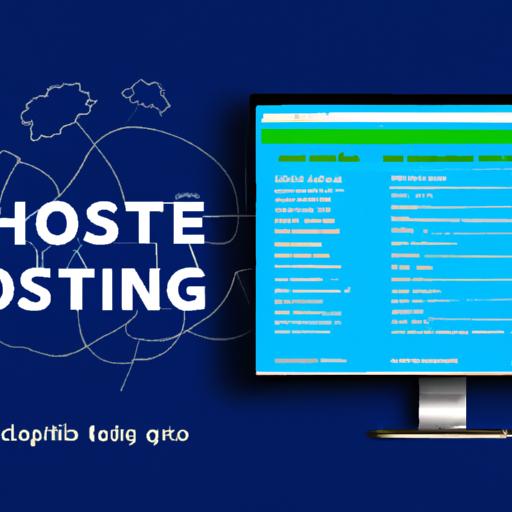Hosting a Web Server: Unlocking the Power of Online Presence
Introduction
In this digital age, establishing an online presence has become crucial for businesses and individuals alike. But have you ever wondered how websites are accessible to the world? Well, that’s where web hosting comes into play. In this article, we’ll explore the ins and outs of hosting a web server and understand why it is essential for your online success.
A. What is web hosting?
Web hosting is a service that allows individuals and organizations to make their websites accessible on the internet. Simply put, it’s like renting space on a server where your website’s files and data are stored. These servers are powerful computers that are constantly connected to the internet, ensuring your website is available 24/7.
B. Importance of hosting a web server
Hosting a web server is the backbone of your online presence. It provides the necessary infrastructure for your website to be accessible to users worldwide. Without reliable hosting, your website may experience frequent downtime, slow loading speeds, and limited resources, hampering user experience and hindering your online growth.
When you host your web server, you gain complete control over your website and its content. You can customize it according to your specific needs, install your preferred software, and ensure optimal performance. Additionally, hosting your web server allows you to have professional email addresses that match your domain, enhancing your brand image and credibility.
Now that we understand the importance of hosting a web server, let’s delve deeper into the different types of web hosting available and how to choose the right one for your needs. Stay tuned for the upcoming sections where we’ll explore shared hosting, VPS hosting, dedicated server hosting, and cloud hosting.
Remember, your website’s performance and accessibility are directly linked to the quality of your web hosting. So, let’s embark on this journey together and unlock the potential of hosting a web server to create a powerful online presence!
Types of Web Hosting
When it comes to hosting a web server, there are various options available to cater to different needs and budgets. Let’s explore the four most common types of web hosting:
A. Shared Hosting
Shared hosting is like living in an apartment building where multiple tenants share the same resources. In this hosting type, your website shares a server with other websites. While it is the most affordable option, it also means sharing server resources like CPU, RAM, and bandwidth. Shared hosting is suitable for small websites with moderate traffic and limited resource requirements.
B. Virtual Private Server (VPS) Hosting
VPS hosting offers a middle ground between shared hosting and dedicated server hosting. It provides a virtual environment where multiple websites coexist on the same physical server, but each website has its own dedicated resources. This ensures better performance, scalability, and security compared to shared hosting. VPS hosting is ideal for growing websites that require more control and resources.
C. Dedicated Server Hosting
Dedicated server hosting offers the highest level of control and resources. With dedicated hosting, you have an entire physical server dedicated solely to your website. This means you have complete control over server configuration, security, and performance. Dedicated server hosting is recommended for large websites with high traffic volumes and resource-intensive applications.
D. Cloud Hosting
Cloud hosting is a flexible and scalable solution that utilizes a network of interconnected servers to host your website. It offers reliability and redundancy, as your website’s files and data are distributed across multiple servers. Cloud hosting allows you to scale resources up or down based on your needs, ensuring optimal performance and minimizing downtime. It is suitable for websites with fluctuating traffic and high scalability requirements.
Now that we have explored the different types of web hosting, it’s important to consider various factors before making a decision. In the next section, we will discuss the key considerations that will help you choose the most suitable hosting option for your web server.
Factors to Consider Before Hosting a Web Server
When it comes to hosting a web server, there are several crucial factors that you need to consider. These factors will determine the performance, reliability, and security of your website. Let’s explore the key considerations before diving into the world of web hosting.
A. Server Requirements
Before selecting a hosting provider, it’s essential to assess your server requirements. Consider the nature of your website and its expected traffic. Will it be a simple blog or a complex e-commerce platform? Analyze the server resources required to ensure optimal functionality. Factors such as CPU power, RAM, and storage capacity should be evaluated to find a hosting plan that aligns with your needs.
B. Bandwidth and Storage
Bandwidth and storage play a crucial role in determining the speed and accessibility of your website. Bandwidth refers to the amount of data transferred between your website and its visitors. If your website has high traffic or multimedia content, opt for a hosting plan that offers ample bandwidth to prevent slow loading times and potential downtime. Additionally, assess the storage capacity provided by the hosting provider to accommodate your website’s files and databases.
C. Scalability
As your business grows, so will your website’s needs. It’s crucial to choose a hosting provider that offers scalability options. Scalability ensures that your hosting plan can adapt to increased traffic and resource requirements. Look for providers that offer easy upgrades, allowing you to seamlessly expand your server resources without major disruptions to your website.
D. Security Measures
Website security should be a top priority for every website owner. Assess the security measures provided by the hosting provider to safeguard your website from potential threats. Look for features such as SSL certificates, firewalls, regular backups, and malware scanning. Additionally, inquire about the level of technical support and response time in case of security breaches or technical issues.
By carefully considering these factors before hosting a web server, you can ensure a smooth and secure online experience for your website visitors. Now that we’ve covered the key considerations, let’s move on to the next section, where we’ll discuss the step-by-step process of hosting a web server.
Steps to Host a Web Server
A. Choose a Hosting Provider
The first step in hosting a web server is to select a reliable hosting provider. With numerous options available, it’s vital to choose one that meets your specific requirements. Consider factors such as server reliability, customer support, pricing, and scalability. Look for hosting providers that offer a user-friendly control panel and robust security measures to ensure your website’s safety.
B. Select a Domain Name
Once you’ve chosen a hosting provider, it’s time to select a domain name. Your domain name is your website’s unique address on the internet. Choose a domain name that reflects your brand, is easy to remember, and aligns with your industry. Remember to check for its availability and register it with a domain registrar. A memorable domain name can leave a lasting impression on your visitors.
C. Set Up and Configure the Server
After selecting a hosting provider and a domain name, it’s time to set up and configure the server. This involves creating an account with your hosting provider and configuring the server settings. Depending on the hosting provider, you may have access to a control panel, such as cPanel or Plesk, where you can manage your server settings, email accounts, and databases. Familiarize yourself with the control panel and customize the server settings according to your needs.
D. Install Necessary Software and Applications
To run your website successfully, you need to install the necessary software and applications on your server. This includes web server software like Apache or Nginx, a database management system like MySQL or PostgreSQL, and any other specific software required by your website, such as content management systems (CMS) like WordPress or e-commerce platforms like Magento. Install these applications using the control panel provided by your hosting provider or manually if required.
E. Upload Website Files
With the server set up and the necessary software installed, it’s time to upload your website files. Use FTP (File Transfer Protocol) or the file manager provided by your hosting provider to transfer your website files from your local computer to the server. Ensure that all files are in the correct directories and that any dependencies or plugins are properly configured.
F. Test and Launch the Website
Before launching your website to the world, it’s crucial to thoroughly test it. Check for any broken links, compatibility issues, or performance bottlenecks. Ensure that all the website’s functionalities are working as expected. Once you’re satisfied with the testing, it’s time to launch your website. Make your website live by pointing your domain name to the server’s IP address and updating the DNS (Domain Name System) records.
Congratulations! You have successfully hosted your web server and made your website accessible to the world. Now, sit back and watch as your online presence takes flight.
Tips for Optimizing Web Server Performance
Ensuring your web server performs at its best is crucial for providing an exceptional user experience and maximizing your website’s potential. Here are some valuable tips to optimize your web server performance and keep your visitors engaged.
A. Regular Server Maintenance
Just like any other technology, your web server requires regular maintenance to stay in optimal condition. Keep your server’s software and operating system up to date to benefit from the latest security patches, bug fixes, and performance improvements. Regularly check for updates, apply them promptly, and schedule routine maintenance tasks to keep your server running smoothly.
B. Caching and Content Delivery Networks (CDNs)
Implementing caching techniques can significantly enhance your web server’s performance. Caching involves temporarily storing frequently accessed data, such as images, CSS files, and HTML pages, closer to your users. By leveraging caching, you reduce the load on your server and decrease page load times. Additionally, utilizing Content Delivery Networks (CDNs) can distribute your website’s content across multiple servers worldwide, ensuring faster delivery to users regardless of their geographical location.
C. Optimizing Website Speed
Website speed plays a vital role in user satisfaction and search engine rankings. Compressing files, optimizing images, and minifying CSS and JavaScript can significantly improve your website’s loading time. Enable browser caching to store static files locally on users’ devices, reducing the need to fetch them from the server on subsequent visits. Moreover, prioritize above-the-fold content to ensure users can view essential elements of your website before the entire page loads.
D. Monitoring and Analyzing Server Performance
Monitoring your web server’s performance is crucial to identify bottlenecks, resolve issues promptly, and make informed decisions for optimization. Utilize monitoring tools to track metrics like CPU usage, memory utilization, disk space, and network traffic. Analyze these metrics regularly to detect any performance anomalies and take appropriate actions to ensure your server operates efficiently.
Remember, optimizing your web server’s performance is an ongoing process. Continuously monitor, analyze, and fine-tune your server to provide an exceptional user experience and stay ahead of the competition.
Stay tuned for the upcoming section, where we’ll explore the concluding remarks and summarize the key takeaways from this article.
Conclusion
In conclusion, hosting a web server is a pivotal step in establishing a strong online presence. By choosing the right hosting provider and configuring your server effectively, you can ensure that your website is accessible, secure, and optimized for performance.
Throughout this article, we’ve explored the various types of hosting options available, such as shared hosting, VPS hosting, dedicated server hosting, and cloud hosting. Each option offers its own set of benefits and considerations, so it’s important to assess your specific requirements before making a decision.
Remember, hosting a web server is not a one-time task. Regular maintenance, monitoring, and optimization are crucial to ensure your website runs smoothly and efficiently. Implementing caching mechanisms, utilizing content delivery networks, and keeping an eye on server performance will help deliver a seamless user experience.
By hosting your web server, you have the power to shape your online presence and establish a strong foundation for your website. Take control of your digital journey and unlock the potential of hosting a web server.
So, what are you waiting for? Dive into the world of web hosting and let your website shine on the vast landscape of the internet. Embrace the opportunities it brings, and watch as your online presence flourishes, captivating audiences and driving success.
Remember, hosting a web server is not just a technical endeavor, but a gateway to connecting with the world. So, choose wisely, optimize diligently, and embark on this exciting journey towards hosting a web server today!






